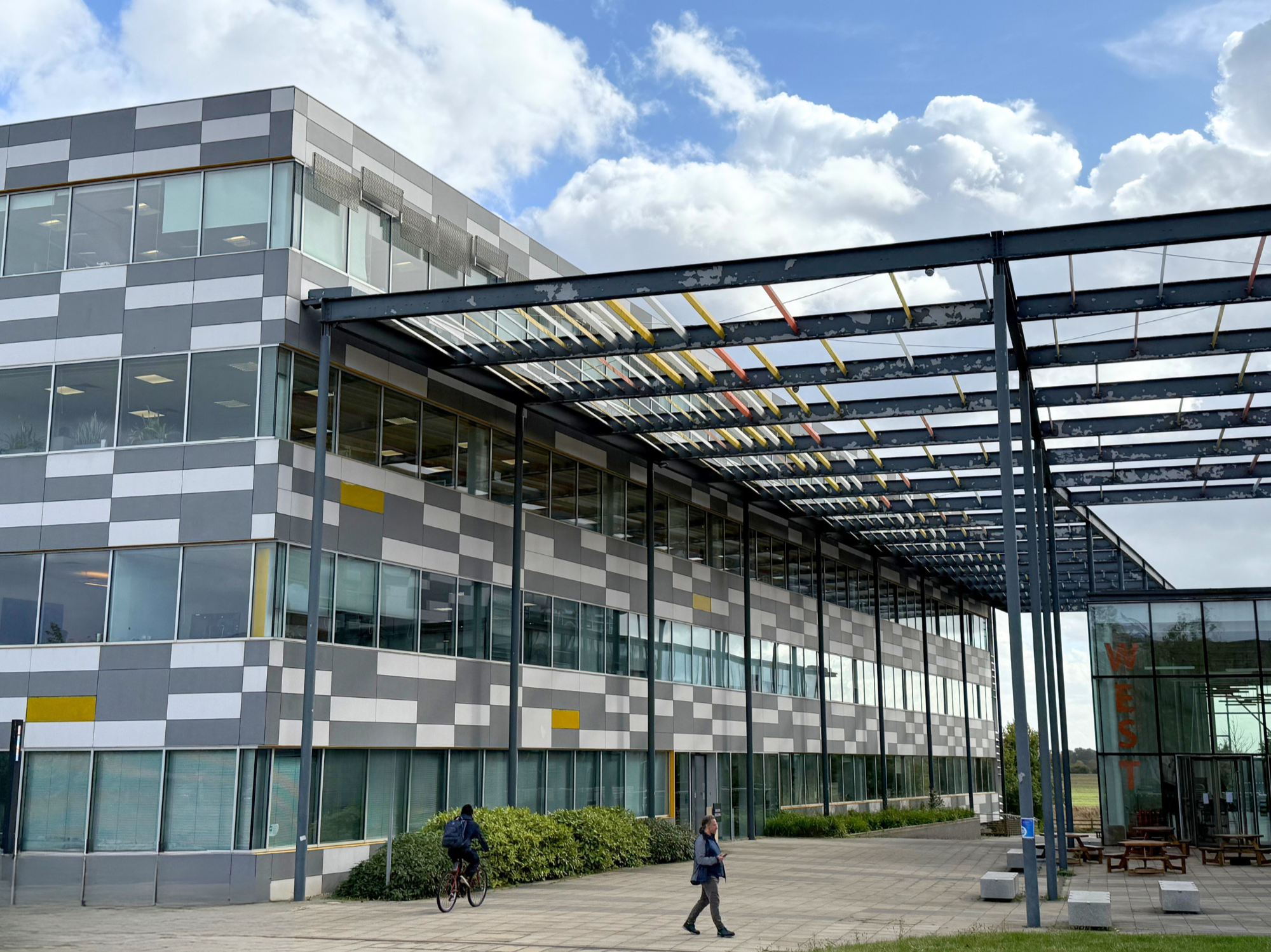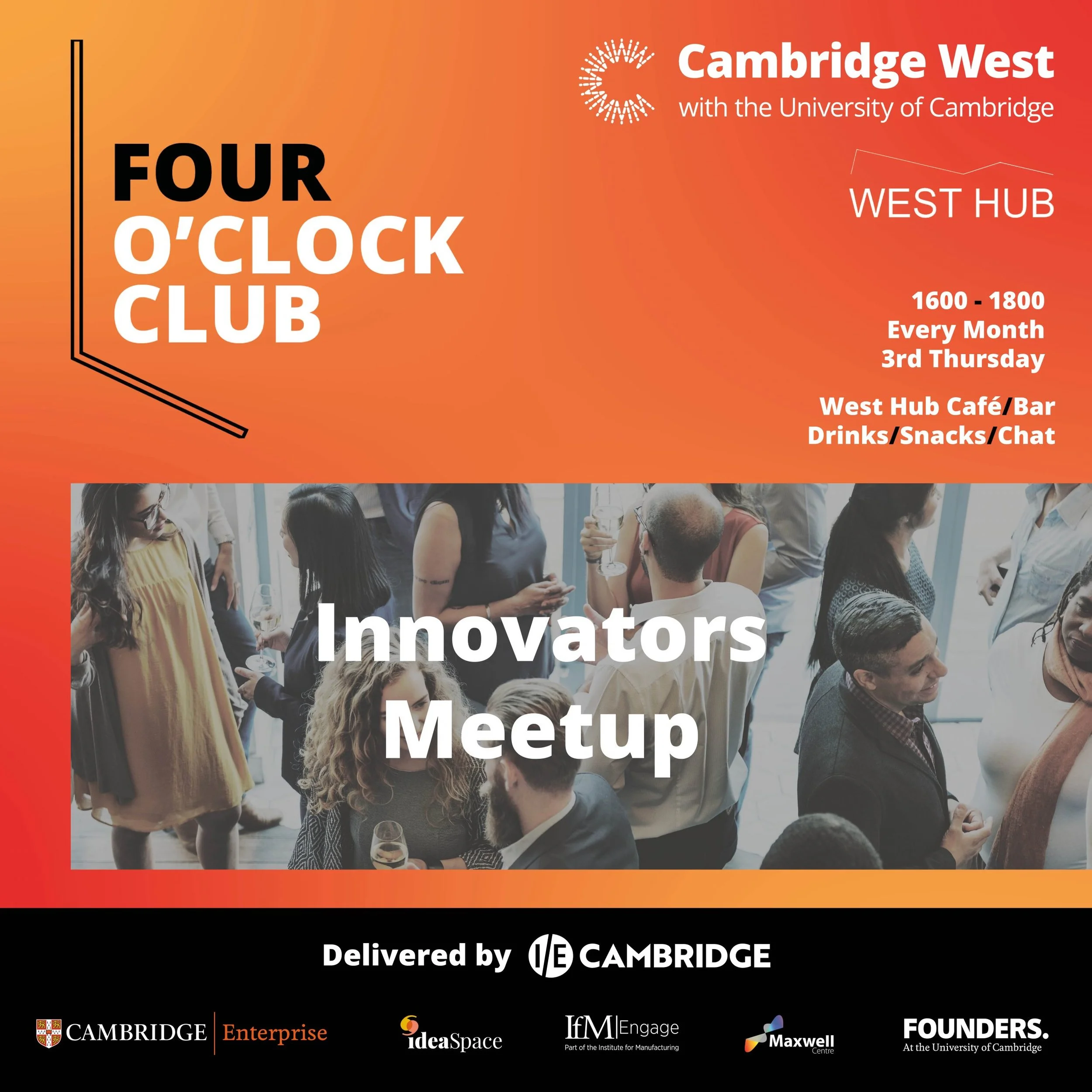CLUSTER
Cambridge West
The Cambridge West is the University of Cambridge’s largest and fastest-growing hub for science, engineering and digital innovation. Located just west of the city centre along JJ Thomson Avenue and Charles Babbage Road, it brings together leading academic departments, translational institutes, and corporate partners in one integrated site.
The campus is central to the emerging Cambridge West Innovation District and is designed to foster deep connections between world-class research and industrial application. New facilities such as the Ray Dolby Centre, home to the Cavendish Laboratory, and the redeveloped Whittle Laboratory anchor a vision for collaborative innovation that spans physics, engineering, digital technologies, and energy transition.
Key Strengths & Focus Areas
West Cambridge’s strengths are rooted in its concentration of physical sciences and engineering departments, paired with a strong emphasis on industrial engagement. The new Ray Dolby Centre positions Cambridge as a global hub for advanced physics and materials research, while the Materials Science & Metallurgy department complements this with leading-edge work in nano-materials, alloys, and functional materials.
The campus is also the centre of Cambridge’s response to the energy transition. The Whittle Laboratory will host the UK’s National Centre for Propulsion and Power, a flagship for net-zero aviation and rapid cycle technology development. Alongside this, the Institute for Manufacturing (IfM) provides expertise in production, supply chains, and industrial strategy, ensuring breakthroughs are translated into impact at scale.
Digital innovation is anchored by the Department of Computer Science & Technology in the William Gates Building, covering AI, cybersecurity, machine learning, and human-computer interaction. The Chemical Engineering & Biotechnology department further connects engineering with the life sciences, supporting Cambridge’s position at the interface of biology and technology. At the heart of collaboration sits the Maxwell Centre, designed as a front door for industrial partnerships and home to the Impulse Programme for tech innovators.
Cambridge West Map
Getting there
The West Cambridge Campus lies just west of the city centre along Madingley Road, with main entrances on JJ Thomson Avenue and Charles Babbage Road. By bike, the site is around ten minutes from the centre via dedicated cycle routes, and there are covered cycle parks across the campus. Frequent buses run along Madingley Road, connecting to the city centre, the railway station, and the Biomedical Campus via the Universal Bus service. For drivers, there are visitor and permit-controlled car parks on site, with the M11 (junction 13) less than five minutes away.
Getting Around
The campus is designed as a walkable grid of wide avenues, with most departments and institutes located within a short distance of each other. Central landmarks such as the West Hub, Maxwell Centre, and Hauser Forum make useful orientation points. Clear pedestrian and cycle paths link the main research buildings, while shuttle and bus stops are positioned along JJ Thomson Avenue for quick access. Food, café, and social spaces are clustered at the West Hub and Hauser Forum, making them natural gathering points for meetings and events.
Research Institutes (University of Cambridge)
Cavendish Laboratory (Ray Dolby Centre)
The University’s Department of Physics, known worldwide as the Cavendish Laboratory, moved into the Ray Dolby Centre in May 2025. This landmark facility is now the UK’s national centre for physics research, housing laboratories for quantum technologies, particle physics, condensed matter, astrophysics, and applied physics. It provides state-of-the-art cleanrooms, cryogenics, and shared characterisation equipment, and has been deliberately designed for openness and cross-disciplinary collaboration.
Institute for Manufacturing (IfM)
Part of the Department of Engineering, the Institute for Manufacturing (IfM) integrates research, education, and practical application in manufacturing systems, industrial strategy, and policy. Its Alan Reece Building on Charles Babbage Road houses academic groups as well as the IfM Engage consultancy, providing direct pathways for companies to apply Cambridge research.
Department of Computer Science & Technology (William Gates Building)
Located on JJ Thomson Avenue, the William Gates Building is home to the Department of Computer Science & Technology. Research spans artificial intelligence, machine learning, natural language processing, computer systems, cybersecurity, and human-computer interaction. The department also runs regular open seminars and provides key talent and spin-outs to Cambridge’s thriving digital economy.
Department of Materials Science & Metallurgy
This department occupies a purpose-built facility on Charles Babbage Road, with world-leading expertise in the development and characterisation of advanced materials. Research areas include biomaterials, electronic and photonic materials, alloys and composites, and sustainable materials for energy and healthcare applications.
Department of Chemical Engineering & Biotechnology (CEB)
The CEB building on Philippa Fawcett Drive unites chemical engineering with modern biotechnology. Research covers process intensification, reaction engineering, metabolic engineering, biosensors, and biopharmaceutical development. The building’s open-plan laboratories and pilot-scale facilities make it a hub for cross-disciplinary projects bridging physical sciences and life sciences.
Whittle Laboratory
The Whittle Laboratory is a world-leading centre for turbomachinery research and is now being redeveloped as the UK National Centre for Propulsion and Power. Its new building, due to complete later this decade, will provide advanced test facilities designed to cut the time needed to develop technologies for net-zero aviation and the wider energy transition.
Nanoscience Centre
The Nanoscience Centre is a 1,800 m² open-access facility providing cleanrooms, low-noise laboratories, and specialist characterisation suites for work at the nanoscale. It supports over 300 researchers across physics, materials, chemistry, engineering and biology, and houses tools for nanofabrication, electron and scanning probe microscopy, and tissue culture. The centre was deliberately designed as a cross-disciplinary environment, enabling collaboration on everything from quantum devices to biomaterials.
Electrical Engineering (CAPE Building)
The Electrical Engineering Division is based in the CAPE Building on JJ Thomson Avenue, home of the Centre for Advanced Photonics and Electronics (CAPE). Research spans photonics, RF and wireless systems, sensors, nanomaterials, power electronics and renewable energy systems. CAPE is distinctive for its close industry collaboration model: global companies including Huawei, Toyota, and Rolls-Royce have partnered through CAPE to co-develop next-generation electronic and photonic technologies.
Department of Veterinary Medicine
Located on Madingley Road at the northern edge of West Cambridge, the Department of Veterinary Medicine combines teaching, clinical services and translational research. It runs the University’s veterinary hospitals (small animal, equine, and farm animal), which act as both training facilities and referral centres. Research strengths include infectious diseases, epidemiology, translational medicine, and animal welfare science. Its location within the cluster strengthens links between veterinary sciences, biomedical research, and One Health initiatives.
Department of Chemical Engineering & Biotechnology (CEB)
The new CEB building on Philippa Fawcett Drive integrates chemical engineering and biotechnology under one roof. It features open-plan teaching labs, pilot-plant scale facilities, and advanced research spaces. The department’s research themes include process intensification, sustainable chemical engineering, reaction engineering, biosensors, metabolic engineering, and biopharmaceutical development. Its design encourages collaboration across disciplines, supporting projects that bridge molecular biology, engineering, and physical sciences — a natural complement to the life science strength elsewhere in Cambridge.
Corporate Research + Business Bases
SLB (Schlumberger) Cambridge Research
SLB, formerly Schlumberger, operates one of its principal research centres on the West Cambridge site. The Cambridge facility focuses on advanced sensing, data science, and technologies for the energy transition. It houses multidisciplinary teams working on digital platforms, subsurface imaging, and new energy systems. As part of SLB’s global R&D network, the site both develops proprietary technology and partners with universities and industry through structured alliance programmes. SLB collaborates closely with the University of Cambridge on joint research and supports innovators via academic partnerships, scholarships, and co-development opportunities across digital and energy technology domains.
British Antarctic Survey (BAS)
The British Antarctic Survey’s Cambridge headquarters is based at High Cross, West Cambridge. BAS is a world leader in polar science, tackling urgent global challenges such as climate change, biodiversity, and environmental sustainability. The Cambridge site provides laboratories, workshops, aquaria, and computing facilities, as well as the Aurora Innovation Centre, a dedicated space for cross-disciplinary collaboration. BAS actively partners with innovators through its Innovation Team, Entrepreneur-in-Residence scheme, and a network of Innovation Champions. These programmes connect researchers, technologists, and entrepreneurs to develop solutions with real-world impact, from advanced sensors and climate models to logistics and environmental monitoring systems.
AVEVA
AVEVA, headquartered at High Cross on Madingley Road, is a global leader in industrial software that enables the digital transformation of industries from energy and manufacturing to infrastructure. Its Cambridge base anchors R&D and corporate activity within the West Cambridge cluster. AVEVA is known for its industrial data platforms, digital twins, and design software that help companies improve efficiency and sustainability. The company partners extensively with innovators through its 6,000-strong partner ecosystem, including global alliances, technology integrations, and academic collaborations. By working with startups, integrators, and universities, AVEVA helps accelerate adoption of digital technologies in industrial settings worldwide.
Plugging In to the Cluster
Innovator Support
Walk into ideaSpace at the Hauser Forum (or its branches in City or South) and you’ll immediately sense the energy of possibility. This is not just workspace — it’s a place where early-stage founders mix with serial entrepreneurs, swap ideas over coffee, and find mentors willing to lean in. Importantly, you don’t have to be a Cambridge student or researcher to join — ideaSpace is open to the wider community.
Next, the Maxwell Centre anchors the science–industry interface on the West Cambridge site. Its Impulse programme is a three-month “action-learning” accelerator where founders refine business models, get matched with mentors, deliver investor-style pitches, and expand networks. It invites applications from PhDs, postdocs, early-stage entrepreneurs, and technical professionals — not just those from Cambridge.
A different kind of leap comes through the Hermann Hauser Frontier Lab. Though located beyond Cambridge, it remains deeply connected to the local ecosystem by offering deep-tech founders the chance to scale technologies in domains like AI, quantum, biotech, and energy. The programme is open internationally, with a select group of startups entering a week-long intensive in Tyrol combined with mentoring and demo preparation.
Finally, the Broers Building, part of the Hauser Forum cluster, serves as a physical anchor for companies bridging research and commerce. Within its walls you’ll find small to medium enterprises working side-by-side with University pluggable labs and commercialisation units. Recent tenants include Nu Quantum and Next Gen Diagnostics, which expanded their space there to deepen their R&D operations.
Each of these places isn’t just about desks and labs — they’re entry points into Cambridge’s innovation ecosystem. If you’ve got a technology, idea, or ambition, you can tap into this network.
How to Get Involved
If you’re an entrepreneur, researcher, or professional with an idea, there are several ways to plug into Cambridge’s innovation support:
Need community + workspace? → Join ideaSpace, open to anyone, with hubs in West, City, and South Cambridge.
Want to accelerate a new venture? → Apply for the Impulse Programme at the Maxwell Centre (open to non-University founders).
Scaling deep-tech internationally? → Explore the Hermann Hauser Frontier Lab, designed for ambitious frontier-tech startups.
Looking for R&D space with University links? → Consider tenancy at the Broers Building within the Hauser Forum.
Together, these spaces form an open door into Cambridge’s ecosystem — whether you’re starting out, scaling up, or seeking a base of operations.
Events in the cluster
Four O’Clock Club
4pm-6pm Third Thursday of every month @West Hub
The Four O’clock Club is a monthly ‘Innovators Meetup’ at 4 o’clock pm at the West Hub Café/ Bar. It’s the perfect chance to grab a drink, enjoy some food, and chat with others from the innovation community, including founders, aspiring entrepreneurs, investors and mentors.
This is a repeating event and will take place every month, on the third Thursday, so refer to the events section of the Cambridge Enterprise website and make it part of your monthly routine.
The event is relaxed and informal, with great people, interesting ideas and a shared passion for innovation.
The event is held in partnership with ideaSpace / Cambridge Enterprise/ Founders at the University of Cambridge/ Maxwell Centre, University of Cambridge/ Institute for Manufacturing (IfM), University of Cambridge/ West Hub/ Cambridge West







